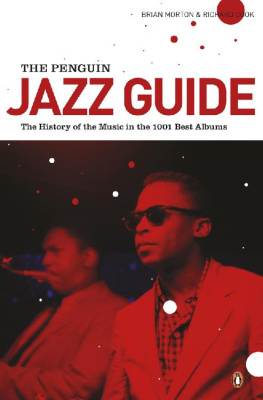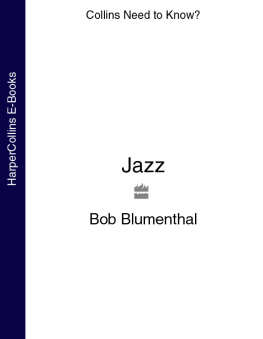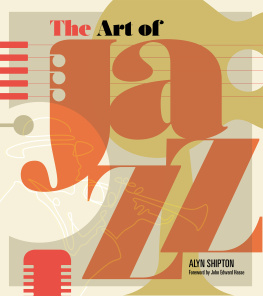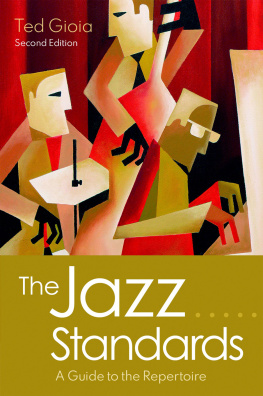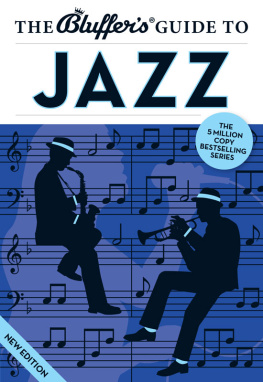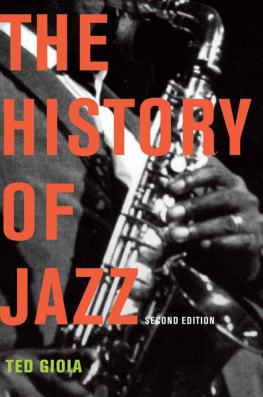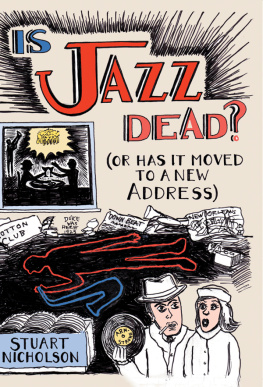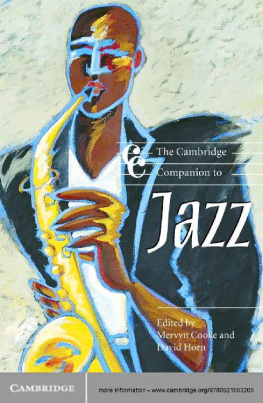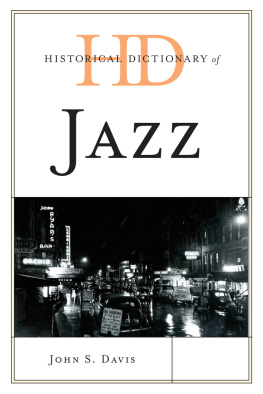PENGUIN BOOKS
The Penguin Jazz Guide
Richard Cook was born in Kew and spent virtually all of his life in or around that part of London. An early passion for record collecting helped push him towards jazz and both interests endured. He got paid for a piece of music writing in 1979 and was so impressed that he kept going. He edited the Wire for seven years and was founding editor of Jazz Review ; he also wrote for the Sunday Times , the New Statesman and Punch at different times and, in addition to the first eight editions of this book, was the author of a biography of the Blue Note label, a study of Miles Davis and Richard Cooks Jazz Encyclopedia , published by Penguin. He also presented a well-liked and thoroughly idiosyncratic jazz programme on London local radio, and made some documentaries for BBC Radio 3; didnt like cameras much, though. Horse racing and malt whisky were his other passions and the only subjects on which he and his co-author ever disagreed. Sadly, Richard Cook succumbed to cancer in the late summer of 2007. He is greatly missed.
Brian Morton was born in Paisley. He was first published at the age of sixteen and has never stopped, though he has also worked as an academic, a newspaper journalist and a broadcaster on BBC Radios 3 and 4, and on BBC Radio Scotland, where he presented a daily arts programme for eight years. Jazz and improvisation gradually won out over other musical enthusiasms. Writing gradually won out over playing, and his improvising ensembles The Golden Horde, Phlogiston and People Without Government are now a distant memory. He lives with his wife, the landscape photographer Sarah MacDonald, and son John on a small farm in the west of Scotland. His older girls Fiona and Alice are there much of the time, too. Unlike Mr Cook, who was a devoted Islay malted man, Morton favours the great Speysides. With a good few drops of gypsy blood in his veins, he reckons he was a better judge of horseflesh, too. He misses the arguments.
Brian Morton and Richard Cook
The Penguin Jazz Guide
THE HISTORY OF THE MUSIC IN THE 1,001 BEST ALBUMS

PENGUIN BOOKS
PENGUIN BOOKS
Published by the Penguin Group
Penguin Books Ltd, 80 Strand, London WC2R 0RL, England
Penguin Group (USA) Inc., 375 Hudson Street, New York, New York 10014, USA
Penguin Group (Canada), 90 Eglinton Avenue East, Suite 700, Toronto, Ontario, Canada M4P 2Y3 (a division of Pearson Penguin Canada Inc.)
Penguin Ireland, 25 St Stephens Green, Dublin 2, Ireland
(a division of Penguin Books Ltd)
Penguin Group (Australia), 250 Camberwell Road, Camberwell, Victoria 3124, Australia (a division of Pearson Australia Group Pty Ltd)
Penguin Books India Pvt Ltd, 11 Community Centre, Panchsheel Park, New Delhi 110 017, India
Penguin Group (NZ), 67 Apollo Drive, Rosedale, North Shore 0632, New Zealand
(a division of Pearson New Zealand Ltd)
Penguin Books (South Africa) (Pty) Ltd, 24 Sturdee Avenue, Rosebank, Johannesburg 2196, South Africa
Penguin Books Ltd, Registered Offices: 80 Strand, London WC2R 0RL, England
www.penguin.com
First published 2010
Copyright Brian Morton and the Estate of Richard Cook, 2011
All rights reserved
Except in the United States of America, this book is sold subject to the condition that it shall not, by way of trade or otherwise, be lent, re-sold, hired out, or otherwise circulated without the publishers prior consent in any form of binding or cover other than that in which it is published and without a similar condition including this condition being imposed on the subsequent purchaser
ISBN : 978-0-14-195900-9
CONTENTS
RECORDINGS
INTRODUCTION
For a major art form, jazz is still disarmingly young. It is possible, even now, to speak to a man who once listened to men who had been present at the birth of the music. This means that nothing in jazz is impossibly remote, and yet it too has its event horizon, for we can know nothing or nothing beyond hearsay of jazz before it was taken down and preserved on record. To that degree, the history of jazz is the history of jazz recording.
Not until Stravinsky was a classical career significantly shaped by recordings, but jazz came along at a remarkable moment of cultural and technological change. The means to preserve and reproduce it were there from the beginning, and this played some part in the musics unprecedentedly rapid spread. If we take the Original Dixieland Jazz Bands pioneering jazz recordings of January and February 1917 as the moment the musics history begins, then by the end of the decade the music was not just known by a popular craze across Europe, and by the middle of the next decade it thrived on every continent.
Jazz was the first cultural phenomenon to justify the term viral. Three different contagions stalked the world in 1918 and 1919. The most obvious was so-called Spanish flu, which actually had its origins in Midwest army camps and was carried to Europe when American soldiers began to be sent in support of the war against the Kaiser. By 1920, the pandemic had claimed what is now estimated to be between 50 million and 100 million lives across the globe. There might seem little connection between the H1N1 virus and a new form of popular music, but the parallels are striking. Jazz spread along the very same vectors, brought out of America to Europe, Asia, South America and Australasia by representatives of a country which had suddenly turned its back on its isolationism and was anxious to bring the American message to the world. As if to confirm the connection, whenever the jazz bug bit, moral guardians were quick to characterize the music itself as febrile and convulsive, and instinctively likened it to an infection: jazz was hot; those who danced to it appeared to be in the grip of dangerous rigours; it exhausted the body and depleted the spirit. And it was unstoppable, carrying off the young and the fit, much as the flu did.
There was a third contagion. In 1917, the Tsarist government of Russia was overthrown by the Bolsheviks, a party whose avowed aim was the world spread of Communism. Almost as soon as it was born and with scant regard to the ironies of presenting a music born in the aftermath of slavery as a banner for American freedoms jazz was being presented as the music of individuality and self-reliance, a freethinking rhythm to set against the fixed march of Marxism. Needless to say, as Frederick Starr and others have shown, Russians were just as susceptible to jazz as everyone else.
It would be convenient to collapse the history of the two world wars of the 20th century and suggest that jazz was carried across the world by the sudden availability of jazz records. In fact, the main vectors remained for the moment human. The Original Dixieland Jazz Band (who lost one member to the flu) were in England a year after the war. James Reese Europes orchestra toured the following year. It would be some time before jazz records became the main vehicle, and only after the original association of jazz and social dance was severed.
It is another of the ironies of the music that at the time and in the place where jazz was at its most creative and fresh, jazz recording was most scant. There are almost no jazz records from New Orleans in the 1920s, though jazz was certainly born there. To complicate matters, it is clear that some musicians at least were suspicious of the music Freddie Keppard feared that his ideas would be stolen or misunderstood what was required of them and changed styles when they entered a recording studio, playing music that was far more formal than any they would have played at a dance or rent party. A music that famously flourished in the whorehouses and shebeens of Storyville was curiously eager to clean up its own act when the world listened.
Next page
